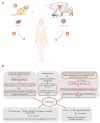Lights and Shadows of TORCH Infection Proteomics
- PMID: 32764347
- PMCID: PMC7464470
- DOI: 10.3390/genes11080894
Lights and Shadows of TORCH Infection Proteomics
Abstract
Congenital abnormalities cause serious fetal consequences. The term TORCH is used to designate the most common perinatal infections, where: (T) refers to toxoplasmosis, (O) means "others" and includes syphilis, varicella-zoster, parvovirus B19, zika virus (ZIKV), and malaria among others, (R) refers to rubella, (C) relates to cytomegalovirus infection, and (H) to herpes simplex virus infections. Among the main abnormalities identified in neonates exposed to congenital infections are central nervous system (CNS) damage, microcephaly, hearing loss, and ophthalmological impairment, all requiring regular follow-up to monitor its progression. Protein changes such as mutations, post-translational modifications, abundance, structure, and function may indicate a pathological condition before the onset of the first symptoms, allowing early diagnosis and understanding of a particular disease or infection. The term "proteomics" is defined as the science that studies the proteome, which consists of the total protein content of a cell, tissue or organism in a given space and time, including post-translational modifications (PTMs) and interactions between proteins. Currently, quantitative bottom-up proteomic strategies allow rapid and high throughput characterization of complex biological mixtures. Investigating proteome modulation during host-pathogen interaction helps in elucidating the mechanisms of infection and in predicting disease progression. This "molecular battle" between host and pathogen is a key to identify drug targets and diagnostic markers. Here, we conducted a survey on proteomic techniques applied to congenital diseases classified in the terminology "TORCH", including toxoplasmosis, ZIKV, malaria, syphilis, human immunodeficiency virus (HIV), herpes simplex virus (HSV) and human cytomegalovirus (HCVM). We have highlighted proteins and/or protein complexes actively involved in the infection. Most of the proteomic studies reported have been performed in cell line models, and the evaluation of tissues (brain, muscle, and placenta) and biofluids (plasma, serum and urine) in animal models is still underexplored. Moreover, there are a plethora of studies focusing on the pathogen or the host without considering the triad mother-fetus-pathogen as a dynamic and interconnected system.
Keywords: TORCH; congenital abnormalities; infections; mass spectrometry; pregnancy; proteomics.
Conflict of interest statement
The authors declare that the research was conducted in the absence of any commercial or financial relationships that could be construed as a potential conflict of interest.
Figures







References
-
- Adams Waldorf K.M., Nelson B.R., Stencel-Baerenwald J.E., Studholme C., Kapur R.P., Armistead B., Walker C.L., Merillat S., Vornhagen J., Tisoncik-Go J., et al. Congenital Zika virus infection as a silent pathology with loss of neurogenic output in the fetal brain. Nat. Med. 2018;24:368–374. doi: 10.1038/nm.4485. - DOI - PMC - PubMed
Publication types
MeSH terms
LinkOut - more resources
Full Text Sources
Miscellaneous

